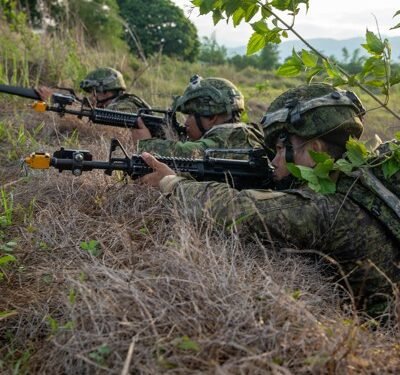HONOLULU—The wargames began with a series of air assaults: a “forcible entry” by U.S. and Philippine soldiers swooping in on a dozen U.S. Army helicopters to seize a piece of land and “build up combat power.” Then the soldiers from both nations began moving across the jungle to find and attack the enemy, before consolidating forces, defending themselves against an attack, and going back on the offensive. All along the way, trainers kept a close eye on what went well—and what could have gone better.
The exercise, which ends June 10, is similar to one conducted last fall by soldiers from the U.S. and Philippines armies in Hawaii. But this time, it’s all taking place 5,000 miles away, at a military base north of Manila. And it’s as much about the trainers—a unit that U.S. Army Pacific calls the Joint Pacific Multinational Readiness Center-Exportable—as it is the training.
“This is the first time that we’ve taken the fully instrumented capability to this scale forward into the region, west of the International Dateline, and this is really an opportunity for us to continue to train side by side with our Philippine army partners,” Maj. Gen. Marcus Evans, commander of the 25th Infantry Division, told Defense One in a phone call from Ft. Magsaysay.
Evans said “continue” because while this is the first JPMRC-X exercise in the Philippines, soldiers from the 25th ID have been in the country since March, participating in an army-to-army exercise called Salaknib, then the joint Balitakan wargames before the current exercise. And those three events are part of a longer chain that began in April, and will continue in Brunei, Malaysia, and Indonesia.
Indeed, U.S. Army Pacific has been tying together its exercises into “a logical and sequential framework” called Operation Pathways for a decade, U.S. Army Pacific commander Gen. Charles Flynn said in remarks at LANPAC 2024. Since 2014, when Flynn was commander of the 25th ID, the effort has grown to include more than 40 exercises in “a campaign for good,” Flynn said.
That campaign has “clear goals promoting our unity and collective commitment, and all of this is tied together by a…strategic land power network,” he said. “Land power is the security architecture that binds this region together.”
Evans said that the Philippines training environment presented a number of challenges—not just because of the hot and humid weather and jungle vegetation, but also because unlike the established JPMRC locations in Hawaii and Alaska, the Philippines lacked the set-up and support for this type of training.
“We have literally had to go in, with the support from the Philippine army, and establish helicopter landing zones. We’ve had to improve roads to be able to get in supplies and to be able to conduct emergency medical evacuation,” he said. “Have literally had to carve portions of the training area to be able to support this level of a collective training exercise.”
The preparation and training will eventually help the Philippine army establish its own training center and evaluate its readiness as it shifts to what Evans called a “territorial defense focus.”
And, Flynn said, the U.S. military benefits from practicing to overcome the logistics and sustainment challenges inherent in moving troops and equipment from Hawaii or Alaska or Washington to the Philippines and onward to other countries.
“I say that we’re the service without a ride. So we need lift, and when you move the U.S. Army, you actually exercise the logistical and transportation enterprise of the Department of Defense,” Flynn said. “And when you move the Army from nation to nation or within the region, and then out of [the continental United States]…just the activity of creating the logistics backbone has to happen in each one of these countries. …It took a lot of work to get there.”
Evans echoed those comments, saying the JPMRC-X exercise is building the division’s “overall readiness,” from the division’s sustainment enterprise to the fact that soldiers are “training on unfamiliar ground, working side by side with Philippine army teammates, and being able to leverage each other’s fires assets, being able to leverage sustainment assets,” as well as establishing personal relationships between individual soldiers.
That all takes “constant practice” and “constant rehearsing,” Flynn said, illustrating “why this land power network is so darn important to the safety, security, peace, and stability of what’s going on out here.”
Still, as the USARPAC commander frequently notes, the Army is not the first service to come to mind when people think about the Indo-Pacific, a theater named after two oceans.
“While all forms of military power are important in this region, land power is often overlooked. It tends to be discounted,” Flynn said.
But the Indo-Pacific “has the largest armies in the world,” he said.
Land forces will be critical in crisis or war, Adm. Stephen Koehler, commander of Pacific Fleet, said at LANPAC.
“We’re in this together,” Koehler said. “If the fight goes down, it will require a team effort with everyone and all of their skills in all domains to succeed”—including the land-based fires that “are an absolute imperative for supporting the Indo-Pacific.”
“The first and second island chains are no longer simply terrain for land forces to defend. They are now terrain from which land forces, along with those allies and partners, can project decisive combat power,” Koehler said. “It takes all of us to maintain a safe, stable, and secure Indo-Pacific.…To prevail, we will continue to innovate, refine our joint and combined capabilities and integration, and ensure regional stability through persistent and combined joint operations.”










